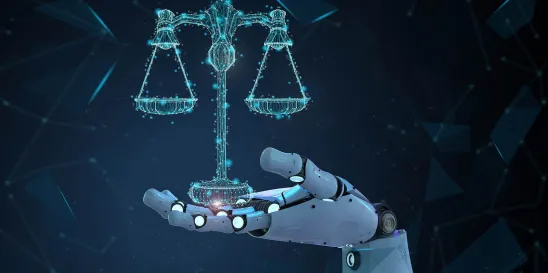This week, we discuss Supreme Court Chief Justice John Roberts’s letter on artificial intelligence and the federal judiciary. Our key takeaways are:
- Chief Justice Roberts asserts that while the federal judiciary is slow to adopt new technologies, its practices are eventually transformed by the technological revolutions that overtake the rest of society. He anticipates that this will also be the case with artificial intelligence.
- The Chief Justice anticipates that AI will have positive and negative impacts on the operation of the federal judiciary, increasing both efficiency and accessibility while potentially promoting bias.
- While Chief Justice Roberts acknowledges that AI will transform the job of a judge, he asserts that the degree of subtle discretion that is required to pass fair judgments makes the role of human judges indispensable for the time being.
Chief Justice Roberts Pens End-of-the-Year Letter on AI and the Federal Judiciary
Discussions surrounding federal artificial intelligence regulation have largely focused on developments in the executive and legislative branches, as regulators, committees, and agencies from these branches have produced the bulk of publicly available statements and proposals on artificial intelligence. But while coverage has skewed towards legislative and executive branch efforts on AI, leaders in the judiciary have also been considering the potential impacts of AI on their work.
In his “2023 Year-End Report on the Federal Judiciary,” Chief Justice John Roberts provides his reflections on the way AI will “transform” the work of the federal judiciary. While he doubts that AI will replace the work of human judges, he is confident that “judicial work…will be significantly affected by AI.”
Contextualizing the AI Revolution
While Chief Justice Roberts recognizes the unique implications of AI technologies, he believes that AI, in some ways, resembles other technologies that were at first tentatively, and then enthusiastically, adopted by the federal judiciary.
Tracing the development of brief drafting in the federal judiciary from the inkwell and quill era to that of typewriters and, finally, personal computers, Chief Justice Roberts notes that like “the rest of society, if not quite as quickly, the federal judiciary has adapted its practices to meet the opportunities and challenges of new technologies.”
These technological developments, Chief Justice Roberts asserts, have transformed the operation of the federal judiciary. E-discovery has increased efficiency and has allowed lawyers to cope with “the explosion of electronic discovery materials created and preserved in the digital age.” Trial presentation software has “radically changed how lawyers present and jurors receive evidence in court.” The Chief Justice asserts that these and other technological innovations have had positive ramifications, “allowing litigants, lawyers, and courts to lock in efficiency gains that do not undercut other important legal or constitutional rights.”
It is within this broader history of successive waves of technological development transforming the work of the federal judiciary that the Chief Justice analyzes the emergence of AI technologies.
Impact of AI on the Federal Judiciary
In his end-of-the-year reflections, Chief Justice Roberts predicts that AI will have both positive and negative impacts on the operation of the federal judiciary.
On the positive end of the spectrum, the Chief Justice asserts that AI will contribute to the efficiency gains won by prior technological advancements, such as digitization. Furthermore, he hopes that AI will continue to drive “new, highly accessible tools that provide answers to basic questions” for those who cannot afford a lawyer. In this way, AI can “increase access to justice, particularly for litigants with limited resources.”
However, Chief Justice Roberts warns that the increasing integration of AI in the federal judiciary can also produce unjust outcomes. The Chief Justice notes that already, unscrupulous lawyers are submitting AI-produced legal briefs that cite “non-existent cases.” (While not mentioned by the Chief, last week, former Trump counsel/fixer Michael Cohen admitted giving his lawyers cases generated by AI to assist his petition for a reduction of his prohibition that turned out not to exist.)
Looking forward, Chief Justice Roberts notes that certain “legal scholars have raised concerns about whether entering confidential information into an AI tool might compromise later attempts to invoke legal privileges.” In consideration of the use of AI tools by judges, Chief Justice Roberts notes that the deployment of AI in criminal cases to make “largely discretionary decisions that involve predictions has generated concerns about due process, reliability, and potential bias.”
Despite these potential issues, the Chief Justice is certain that AI will play an important role in the legal profession and, as such, asserts that as “AI evolves, courts will need to consider its proper uses in litigation.”
The Job of Judge: Transformed but Not Replaced
Experts expect that generative AI will usher in significant shifts in the labor force, with some predicting that AI will drive 12 million occupational transitions by 2030. In the midst of these transitions, Chief Justice Roberts predicts that AI will transform rather than eliminate the job of a human judge.
Chief Justice Roberts acknowledges that certain domains of judging have been automated. For instance, in the US Open tennis tournament, optical technology is now used to determine whether serves are in-bounds. However, he asserts that, unlike tennis tournaments, “legal determinations often involve gray areas that still require application of human judgment.” In other words, passing judgment on complex legal matters may require a degree of discretion beyond the capabilities of current AI systems.
But this is not to say that the Chief Justice denies that AI can be usefully deployed in the federal judiciary. He is hopeful that AI can be used to provide “just, speedy, and inexpensive” resolution of cases, as the Federal Rules of Civil Procedure directs. The Chief Justice asserts that as “AI evolves, courts will need to consider its proper uses in litigation.”
“I predict that human judges will be around for a while. But with equal confidence I predict that judicial work — particularly at the trial level — will be significantly affected by AI,” concludes Chief Justice Roberts.
Raj Gambhir contributed to this article.






 />i
/>i


